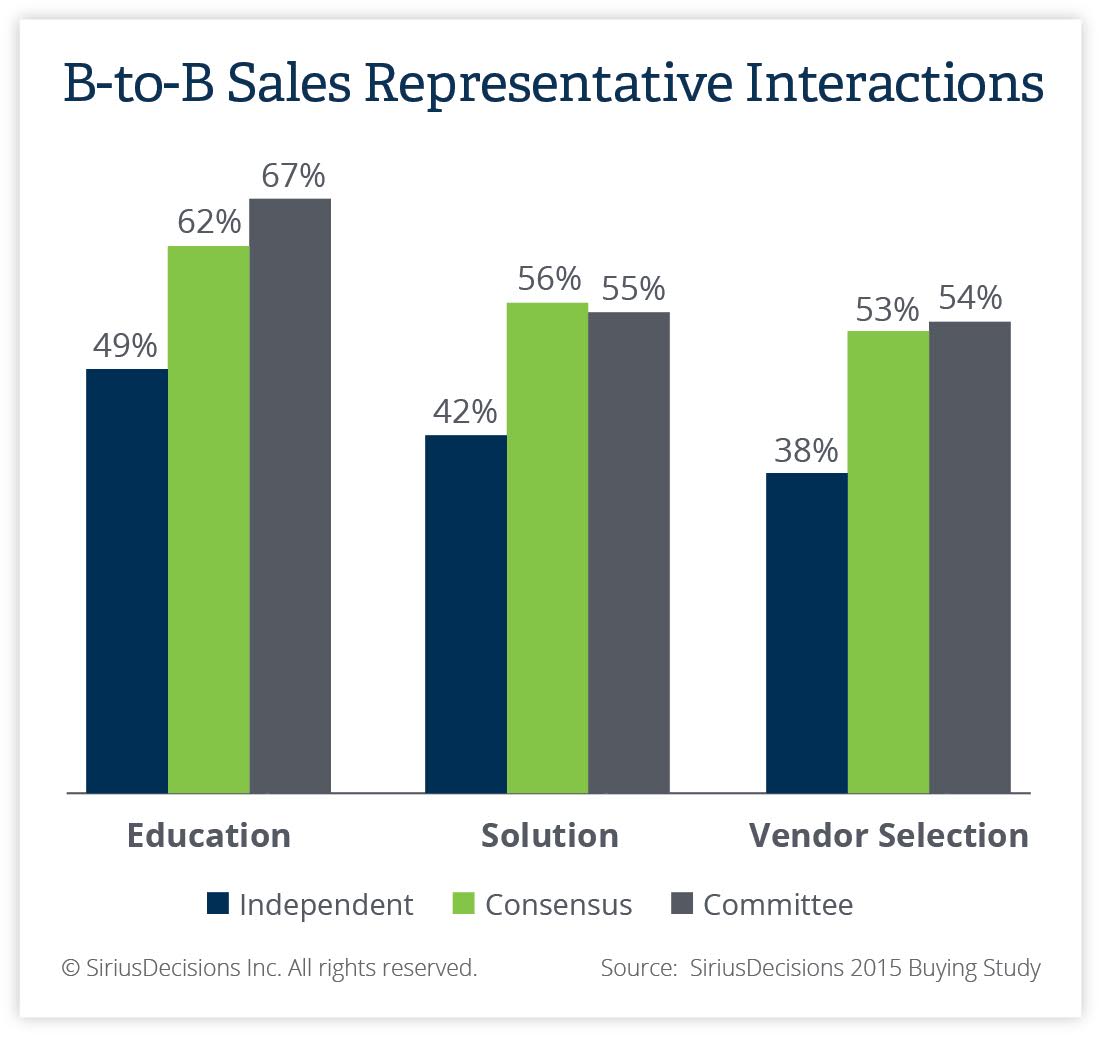B2B Sales Reps Still Matter
- The SiriusDecisions 2015 B2B Buying Study analyzed the buying behaviors of more than 1,000 B2B executives
- Our research highlighted that sales rep interaction with buyers occurs across three types of buying scenarios
- The new way to think about B2B buying is that human interactions still occur and matter, and furthermore facilitate a buying process
While popular opinion would suggest that digital marketing is disintermediating B2B sales reps, our research findings show the contrary. We discovered that buyers still interact with sales reps during every stage of the decision making process at least half the time. We also found that the type of decision – or buying scenario – greatly impacted the number and types of interactions.
The SiriusDecisions 2015 B2B Buying Study, conducted earlier this year, analyzed the buying behaviors of more than 1,000 B2B executives who were involved in a significant B2B purchase decision within the past six months. The data collected represents an estimated half-billion dollars in B2B purchases across North America and Europe.

This chart illustrates the percentage of the 1,005 respondents who reported that they – or someone else from their organization – received information from a sales rep from the winning provider organization (vendor) to help inform their decision at that phase.
An even bigger “aha” moment for us was discovering that rep interaction occurred across all three types of buying scenarios we identified in the study: independent decisions (a simple buying process with low expenditure and short time frame), consensus decisions (a buying process requiring a “vote” by multiple buying centers or colleagues and usually taking one to two quarters), and committee decisions (a complex buying process that is tiered and phased, and requires the decision to be brought up to a higher level of management or leadership in the organization, with an average of six to 10 people involved).
As the chart exemplifies, we were most intrigued by the finding that even in the independent buying scenarios that would be traditionally considered “transactional” or “e-commerce,” personal interactions occurred between the provider and buyer organizations – most notably, dialogues and interactions with a sales representative. Loud and clear, buyers expressed the need for personal interactions to create trust, validation and confidence in the decision they were making.
This is ultimately why the sales rep still matters. Furthermore, the buyer’s need for a contextual fit of the information that’s being delivered to them to inform their decisions was also articulated as a key driver for interacting with a representative from the provider organization.
The study’s other key findings included the following:
- The price point of an offering affects the number and type of interactions that occur between a buyer and provider.
- As the price point of an offering goes up, human interactions between the buyer and the provider also increase. But even at low price points, human-to-human interactions occur.
- More than half the time, sales rep involvement starts at the beginning of the buyer’s journey. In complex buying scenarios, sales rep involvement starts at the beginning of the journey two-thirds of the time.
- The highest level of reported buyer/seller interaction for all buying scenarios occurred during the education phase of the buyer’s journey (the first decision gate in the purchasing decision process).
- Not only do buyers interact with a sales representative from the winning provider organization in all phases of their decision making process, but they also overwhelmingly describe those interactions as positive (in more than 85 percent of the buying experiences studied).
The new way to think about B2B buying is that human interactions still occur and matter, and the rise of digital marketing does not mean that personal interactions have gone away. While providers are interacting in new digital ways, just because buying behavior is done digitally does not mean that sales representatives are no longer required to instigate or facilitate a buying process.
The SiriusDecisions Buying Decision Process Framework is a conceptual model that illustrates how the cognitive decision process is made when organizations buy from other organizations. This framework helps business leaders devise go-to-market strategies aligned to the buyer’s journey to inform content, campaigns and sales enablement strategies. Download a complimentary copy of The SiriusDecisions Buying Decision Process Framework. Licensed seat holders can access to the full research brief our research portal.